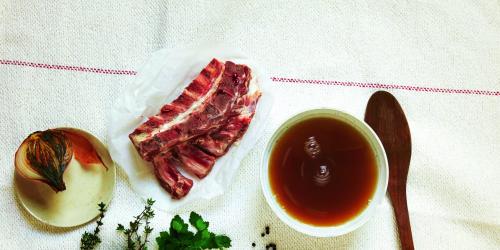What is a lightened?
It displays at least 25% less fat , sugar or salt than its basic version. Cooked dishes, dairy products or cold cuts lighten their composition. These lighter dishes look like our favorite cooked dishes but are better for your health.
Less rich in calories?
When the starter feed contains only fat or sugar , its lighter version can provide up to 50% fewer calories . Thus, butter low fat contains 41 g of fat per 100 g against 82 g per 100 g in its original version, it changes everything! But stay alert with products containing both fat and sugar. A reduction of one or the other does not necessarily mean a reduced calorie intake. A 25% reduction in sugar can be offset by an increase in fat and vice versa. This was the case of 0% GM yogurts with very sweet fruits. In the end, the light version is as caloric as the reference without our being aware of it. Do not be fooled by the lightened word, let's look at the label before buying.
So, long live the all-lightened?
For pleasure foods like chocolate, we prefer the original version that we consume with happiness and moderation! Be careful not to fall into the trap of quantities. It's not because my butter is half as fat that I can put three times more. Under these conditions, there is no risk of losing weight but to take it.
Do they really lose weight?
They are not considered a diet method but as a tool among others (play sports, reduce quantities, fight against snacking ...). They allow to know precisely the quantities and the number of calories , which simplifies our life. It is recalled that no food (lightened included) does fatten or lose weight. It's all about behavior and quantity.
And for children?
Children and teens have no interest in removing or reducing fat from their diet. They are essential to their brain development. These are the quantities of fast sugars , saturated animal fats (frying, processed cheese, etc.) that must be monitored to avoid the risk of overweight .
How to consume them?
By choosing his products. A yoghurt or butter addict will have everything to gain if she takes the lighter version of her favorite product. They also replace some dishes that are stuffed when laziness catches us. One can thus feast of a moussaka or a dish of lightened cannelloni. Not every day.
Light, diet or lightened?
The expression light has the slightest result in light, it concerns products low in sugar and not in fat. Even if we see products cumulating 0% (in fat) and light. The interest is obvious on the sodas very loaded with sugar. A can of Coke contains the equivalent of 7 pieces of sugar, it can advantageously replace the light version (or diet as say the Americans).
What about our baby food we opt for the light version or not?
Chocolate
Classic version: between? 500 and 550 kcal / 100 g for black. Ditto for milk, a little less oily but sweeter.
Light version: only 2% sugar thanks to sweeteners. But they are laxative. And to compensate for the taste side, manufacturers add fat. But we exceed 500 kcal! Interesting only for diabetics.
Advantage in ... real chocolate. The right dose: 2 squares / day.
Soft drinks
Classic version: 1 can of 33 cl is 150 kcal and, especially, sugar, the equivalent of 6 pieces.
Light version: instead of sugar, we find sweeteners, such as aspartame. Result: barely 1 calorie per glass.
Advantage to ... sodas lights, but not every day because their taste accustoms us to consume "sweet".
Cheese
Classic version: 45% fat on average. But those with hard paste (Gruyere, Emmental) are fatter than those with soft dough (Camembert).
Light version: up to 30% less fat because skim milk is used. A real gain, but the taste is often more bland!
Advantage to ... the lightened version. But an emmental light is as caloric as a normal camembert.
The biscuits
Classic version: about 450 kcal / 100 g for biscuits and fruit versus 500 kcal for chocolate ones, more fat. All are very sweet.
Light version: sometimes a little less oily but also sweet (even more) than the others! And never less than 400 kcal / 100 g: at best, it saves 5 kcal / cake.
Advantage to ... those who make us feel the most. And we stop at 2.
The mayonnaise
Classic version: 70% minimum oil and about 100 kcal / spoon.
Light version: some of the fat is replaced by water and a thickener. So, it is up to 5 times less caloric. But we find 5 g of lipids in one brand and more than 40 g in another. Open the eye!
Advantage to ... the mayo (really) lightened, provided you do not put 2 spoons instead of 1!
The aperitif cakes
Classic version: a real caloric bomb (about 90 kcal / handle, even more for peanuts), stuffed with fat and salt.
Light version: about 10% fat and 25% less salt. But, still, 400 kcal / 100 g minimum and we tend to eat more.
Advantage to ... classic cookies. We know that they are very caloric and that brakes us a little. The best: pretzels, not too fat.
Yogurt
Classic version: only 3% fat, except for those with cream (type "greedy" or "Greek"). Whole milk yoghurt is about 55 kcal.
Light version: 40 kcal / pot for "0% fat", made with skim milk. And the "fruit" versions with sweeteners are at 50 kcal.
Advantage to ... whole yogurts, more tasty. But for fruity yogurt addicts: the lights.
Breakfast cereals
Classic version: apart from crispy mueslis, o very oily, most display less than 400 kcal / 100 g.
Light version: with around 400 kcal / 100 g, the chocolate cereals stamped "line" are caloric, sweeter, fatter than average! Those with fruits make an effort on fat but also remain sweet.
Advantage to ... classic cereals. The best: choose wheat petals or plain corn.




